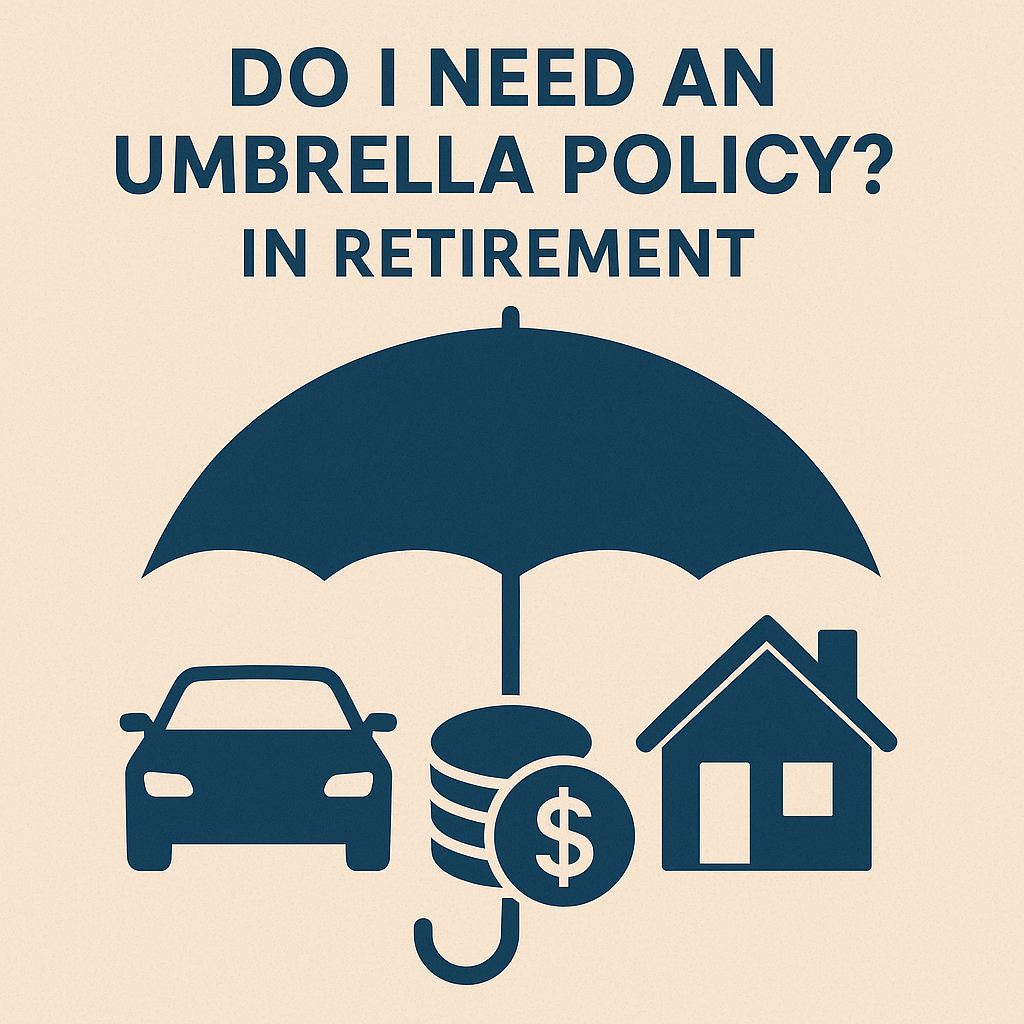Do I Need an Umbrella Policy?

Umbrella Insurance for Retirees
This is a question we hear often — especially from retirees who’ve worked hard to build a nest egg. That nest egg might include your home, car, or boat — all covered by property and casualty (P&C) insurance — as well as liquid assets like IRAs, 401(k)s, brokerage accounts, and HSAs. With more at stake in retirement, it’s only natural to ask whether an umbrella policy is worth adding.
What Umbrella Insurance Is Not
A common misconception is that an umbrella policy simply increases the replacement coverage for your existing property — such as your home, car, or boat. For example, if your house is worth $500,000 and your vehicles and boat are worth another $100,000, you might think an umbrella policy for $1 million gives you $400,000 more in protection. But that’s not how umbrella coverage works.
Umbrella insurance is not property insurance. It doesn’t pay to repair or replace your assets. That’s what your homeowners, auto, and other P&C policies are for. An umbrella policy doesn’t enhance or expand that type of coverage — it sits on top of the liability limits in those policies.
What Umbrella Insurance Does
Umbrella insurance is designed to protect you from major liability risks. It kicks in when you are sued for damages — typically because of an accident or injury — and the liability limits on your auto or homeowners policy aren’t enough to cover the judgment.
This kind of protection can be especially important for retirees, many of whom have significant liquid assets but limited future income to rebuild if those assets are lost in a lawsuit.
Example Scenario:
Let’s say you carry an auto policy with $300,000 of liability coverage. You’re involved in an accident where the other driver suffers serious injuries and sues you. The court awards $2 million in damages. Your auto insurance will pay the first $300,000, but you’re on the hook for the remaining $1.7 million.
Without umbrella coverage, your assets — including home equity, taxable investments, and potentially even future income — could be at risk.
What Can Be Taken in a Lawsuit Judgment?
If you’re found liable in a lawsuit and owe more than your insurance covers, the court can enforce the judgment using any non-exempt assets. That can include:
- Bank accounts
- Taxable brokerage accounts
- Non-primary real estate
- Vehicles
- Home equity (beyond your state’s homestead exemption)
- Future wages or garnishable income
Assets that are often protected (varies by state):
- 401(k)s, IRAs, and other qualified retirement plans – Protected under federal law (ERISA) or state law, often up to a limit
- Social Security income – Generally protected from garnishment (except for federal debt)
- Some pensions and annuities – May be protected, depending on state law
- HSAs and life insurance cash values – May or may not be protected, depending on state law
⚠️ Important note: Just because something might be protected doesn’t mean it will be. State-specific rules and the aggressiveness of a creditor’s attorney can make exemptions murky. That’s why shielding your net worth with liability coverage is often the better strategy.
How Much Coverage Do You Need?
Start by calculating your exposed net worth — your home equity, liquid assets, investment accounts, and any other non-exempt property.
Umbrella policies are sold in $1 million increments. The most common mistake we see? Overinsuring — taking out a policy well in excess of your actual risk.
Some clients carry $5 million in umbrella coverage while only having $500,000 in exposed net worth. Why? Because it was inexpensive and someone told them to. But having a large policy without a matching asset base can actually make you a target. When lawsuits are filed, opposing attorneys often investigate how much coverage you carry. If you have far more coverage than assets, they may go after the policy just because it’s available.
Some attorneys we work with even advise clients to avoid umbrella coverage altogether if they have minimal exposed assets, simply to reduce visibility in a potential claim. That’s a more cautious legal strategy, but it underscores a key point: umbrella insurance is a tool, not a status symbol.
The Sweet Spot for Most Retirees
For most of the retirees we work with, a $1–2 million umbrella policy is more than enough. These policies are:
- Affordable (often under $300/year)
- Easy to qualify for with basic underwriting
- Quick to set up through your existing insurance provider
- Essential for protecting your liquid net worth and future lifestyle
What To Do Next
If you’ve read this far, your next step is simple: schedule a coverage review with your licensed P&C professional. Most people who are considering umbrella coverage don’t actually need more insurance — they need better insurance. Your time is best spent ensuring that your homeowners and auto policies are properly structured to cover your existing assets. Once that’s in place, evaluate whether an umbrella policy is the right way to protect everything you’ve built.



